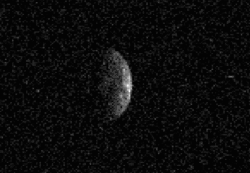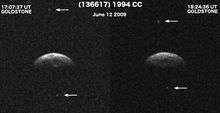(136617) 1994 CC
(136617) 1994 CC is a sub-kilometer trinary[3] asteroid, classified as near-Earth object and potentially hazardous asteroid of the Apollo group.
 | |
| Discovery [1] | |
|---|---|
| Discovered by | Spacewatch |
| Discovery site | Kitt Peak National Obs. |
| Discovery date | 3 February 1994 |
| Designations | |
| (136617) 1994 CC | |
| 1994 CC | |
| NEO · PHA · Apollo [1][2] Earth-crosser | |
| Orbital characteristics [1] | |
| Epoch 4 September 2017 (JD 2458000.5) | |
| Uncertainty parameter 0 | |
| Observation arc | 28.45 yr (10,391 days) |
| Aphelion | 2.3206 AU |
| Perihelion | 0.9551 AU |
| 1.6378 AU | |
| Eccentricity | 0.4169 |
| 2.10 yr (766 days) | |
| 321.07° | |
| 0° 28m 12.72s / day | |
| Inclination | 4.6806° |
| 268.55° | |
| 24.842° | |
| Known satellites | 2[3] |
| Earth MOID | 0.0157 AU · 6.1 LD |
| Physical characteristics | |
| Dimensions | 0.62±0.06 km[4] 0.650 km[3] |
| 2.3886±0.0001 h[3] 2.38860±0.00009 h[4] | |
| 0.3821 (derived)[5] | |
| Sq [4] · Sa [6] · S [5][7] | |
| 17.00[7] · 17.7[1][5] · 18.12±0.84[8] | |
Discovery
1994 CC was discovered by Spacewatch's Jim Scotti at Kitt Peak National Observatory on 3 February 1994.[2] In June 2009 it was shown to be a triple system, i.e. the largest body is orbited by two satellites; only about one percent (1%) of near-Earth asteroids observed by a radar are found to be triple systems such as this one.[9] The only other unambiguously identified triple asteroids in the near-Earth population are (153591) 2001 SN263, which was discovered to be a triple system in 2008, and 3122 Florence, which was found to be a triple system in 2017.
Observations

A team of NASA's Jet Propulsion Laboratory (JPL) (Pasadena, California) scientists led by Marina Brozovic and Lance Benner, made the discovery using radar imaging at NASA's Goldstone Solar System Radar on June 12 and June 14, 2009. They showed that the near-Earth asteroid 1994 CC is a triple system, which encountered Earth within 2.52 million kilometers on June 10, 2009. This relatively close approach to Earth made the discovery possible, as before the approach, scientists knew very little about this asteroid. In fact, 1994 CC is only the second triple system known in the near-Earth objects population.[9]
1994 CC consists of a central object about 700 meters in diameter that has two moons revolving around it. Scientists' preliminary analysis of the system suggests that the moons are at least 50 meters in diameter. In a similar study, the radar observations at Arecibo Observatory in Puerto Rico, led by the Mike Nolan, also confirmed the detection of all three objects. The scientists plan to use the combined observations from the Goldstone and Arecibo observatories to study 1994 CC's orbital and physical properties further.[9]
The next similar Earth flyby for the asteroid 1994 CC will happen in 2074 when the triple system is projected to fly past Earth at a distance of 2.5 million kilometers.[9]
Orbital characteristics of satellites
The orbital properties of the satellites are listed in this table.[10] The orbital planes of both satellites are inclined relative to each other, by approximately 16°. Such a large inclination is suggestive of past evolutionary events (e.g. close encounter with a terrestrial planet, mean-motion resonance crossing) that may have excited their orbits from a coplanar configuration to an inclined state.
| Name | Mass [109 kg] | Semi-major axis [km] | Orbital period [days] | Eccentricity | Inclination (relative to asteroid) [°] |
|---|---|---|---|---|---|
| Beta | ~6 | 1.7 | 1.243 | 0.002 | 95 |
| Gamma | ~1 | 6.1 | 8.376 | 0.192 | 79 |
Numbering and naming
This minor planet was numbered by the Minor Planet Center on 5 December 2006.[11] As of 2019, it has not been named.[2]
See also
- List of notable asteroids
- 2004 FH
- 87 Sylvia
- 433 Eros
- (153591) 2001 SN263
References
- "JPL Small-Body Database Browser: 136617 (1994 CC)" (2017-02-25 last obs.). Jet Propulsion Laboratory. Retrieved 1 June 2017.
- "136617 (1994 CC)". Minor Planet Center. Retrieved 22 March 2017.
- Brozovic, M.; Benner, L. A. M.; Nolan, M. C.; Howell, E. S.; Magri, C.; Giorgini, J. D.; et al. (June 2009). "(136617) 1994 CC". IAU Circ. (9053). Bibcode:2009IAUC.9053....2B. Retrieved 22 March 2017.
- Brozovic, Marina; Benner, Lance A. M.; Taylor, Patrick A.; Nolan, Michael C.; Howell, Ellen S.; Magri, Christopher; et al. (November 2011). "Radar and optical observations and physical modeling of triple near-Earth Asteroid (136617) 1994 CC". Icarus. 216 (1): 241–256. arXiv:1310.2000. Bibcode:2011Icar..216..241B. doi:10.1016/j.icarus.2011.09.002. Retrieved 22 March 2017.
- "LCDB Data for (136617)". Asteroid Lightcurve Database (LCDB). Retrieved 22 March 2017.
- Thomas, Cristina A.; Emery, Joshua P.; Trilling, David E.; Delbó, Marco; Hora, Joseph L.; Mueller, Michael (January 2014). "Physical characterization of Warm Spitzer-observed near-Earth objects". Icarus. 228: 217–246. arXiv:1310.2000. Bibcode:2014Icar..228..217T. doi:10.1016/j.icarus.2013.10.004. Retrieved 22 March 2017.
- Carry, B.; Solano, E.; Eggl, S.; DeMeo, F. E. (April 2016). "Spectral properties of near-Earth and Mars-crossing asteroids using Sloan photometry". Icarus. 268: 340–354. arXiv:1601.02087. Bibcode:2016Icar..268..340C. doi:10.1016/j.icarus.2015.12.047. Retrieved 22 March 2017.
- Veres, Peter; Jedicke, Robert; Fitzsimmons, Alan; Denneau, Larry; Granvik, Mikael; Bolin, Bryce; et al. (November 2015). "Absolute magnitudes and slope parameters for 250,000 asteroids observed by Pan-STARRS PS1 - Preliminary results". Icarus. 261: 34–47. arXiv:1506.00762. Bibcode:2015Icar..261...34V. doi:10.1016/j.icarus.2015.08.007. Retrieved 22 March 2017.
- "Triple Asteroid System Triples Observers' Interest". NASA. 6 August 2009. Retrieved 22 March 2017.
Radar imaging at NASA's Goldstone Solar System Radar [..] revealed that near-Earth asteroid 1994 CC is a triple system
- Fang, Julia (May 2011). "Orbits of Near-Earth Asteroid Triples 2001 SN263 and 1994 CC: Properties, Origin, and Evolution". Astronomical Journal. 131 (5): 154. arXiv:1012.2154. Bibcode:2011AJ....141..154F. doi:10.1088/0004-6256/141/5/154.
- "MPC/MPO/MPS Archive". Minor Planet Center. Retrieved 24 February 2018.
External links
- Spacewatch Discoveries for 1994, Spacewatch NEO Detections by Year, University of Arizona
- Official press release by NASA on triplet system
- (136617) 1994 CC compiled by Wm. Robert Johnston
- Julia Fang, "Orbits of Near-Earth Asteroid Triples 2001 SN263 and 1994 CC: Properties, Origin, and Evolution",
- (136617) 1994 CC at the JPL Small-Body Database